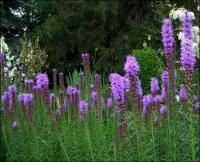Description
Rosy purple spikes in July and August, a flower arranger’s dream
Rosy purple spikes in July and August, a flower arranger’s dream
Rosy purple spikes in July and August, a flower arranger’s dream
Soft, majestic purple-magenta thistles on prickly silver foliage and stems.
Can not ship to: Arizona, Arkansas, Colorado, Connecticut, Idaho, Missouri, Nebraska, Nevada, New Mexico, North Dakota, Oklahoma, Oregon, South Dakota, Texas, Utah, Washington and Wyoming.
Size: 4-6’ x 2”
Care: full sun in moist, well-drained soil
Native: Europe and western Asia
Wildlife Value: Bees, butterflies and birds
Identified by Dioscorides in De Materia Medica for medicinal use around 70 A.D. Chosen as the symbol of Scotland by King James V. According to legend the Scotch thistle helped Scotland fend off a night-time Viking invasion by preventing a sneak attack. It caused the Vikings to scream in pain waking the Scots. Introduced to American gardens in late 1800’s.
Short purple spikes in June-July
Size: 3” x 24”
Care: sun in well-drained soil
Native: Europe & Western Asia
Size: groundcover, rock garden, herb, fragrant foliage, thyme lawn
Thymus from the Greek word for “odor” due to the plant’s fragrance. Ancient Greeks made incense with thyme. This species since at least 1753. Acc’d to Parkinson in 1640 this remedied hysterics in women. Wm. Robinson wrote,”nothing can be more charming than a sunny bank covered with” Thymus serpyllum. LH Bailey extolled it as “prized as an evergreen edging and as cover for rockwork and waste places …The leaves are sometimes used for seasoning.”
SHRUB Boxwood
Size: 24” x 30”
Care: Light to Part shade in well drained, alkaline soil. Do not crowd with other plants, roots prefer no competition. Fertilize regularly for dramatic growth. Prune in early spring. Unlike English boxwood this can be pruned back hard. One of a few shade tolerant evergreens and deer resistant too. Also the most hardy Boxwood.
Introduced from Asia to American and European gardens around 1900 by Ernest Henry “Chinese” Wilson (1876-1930) who scoured Asia for plants.
Small crimson-red bells dangle from July to September
Size: 8’ x 3’
Care: Sun in humusy, fertile, moist well-drained soil. Mulch around the base. Flowers on current year’s stems so cut back to 6-9” in late winter or early spring.
The genus Clematis was named by Dioscordes, physician in Nero’s army, from “klema” meaning climbing plant. The species 1st collected by the “Father of Texas botany,” Ferdinand Lindheimer in 1830’s. Max Leichtin of the Baden Garden sent Clematis texensis to Kew Botanic Garden near London in 1880’s. French nurseryman Francisque Morel sent this selection to William Robinson who named it for his English nursery at Gravetye Manor in 1914.

